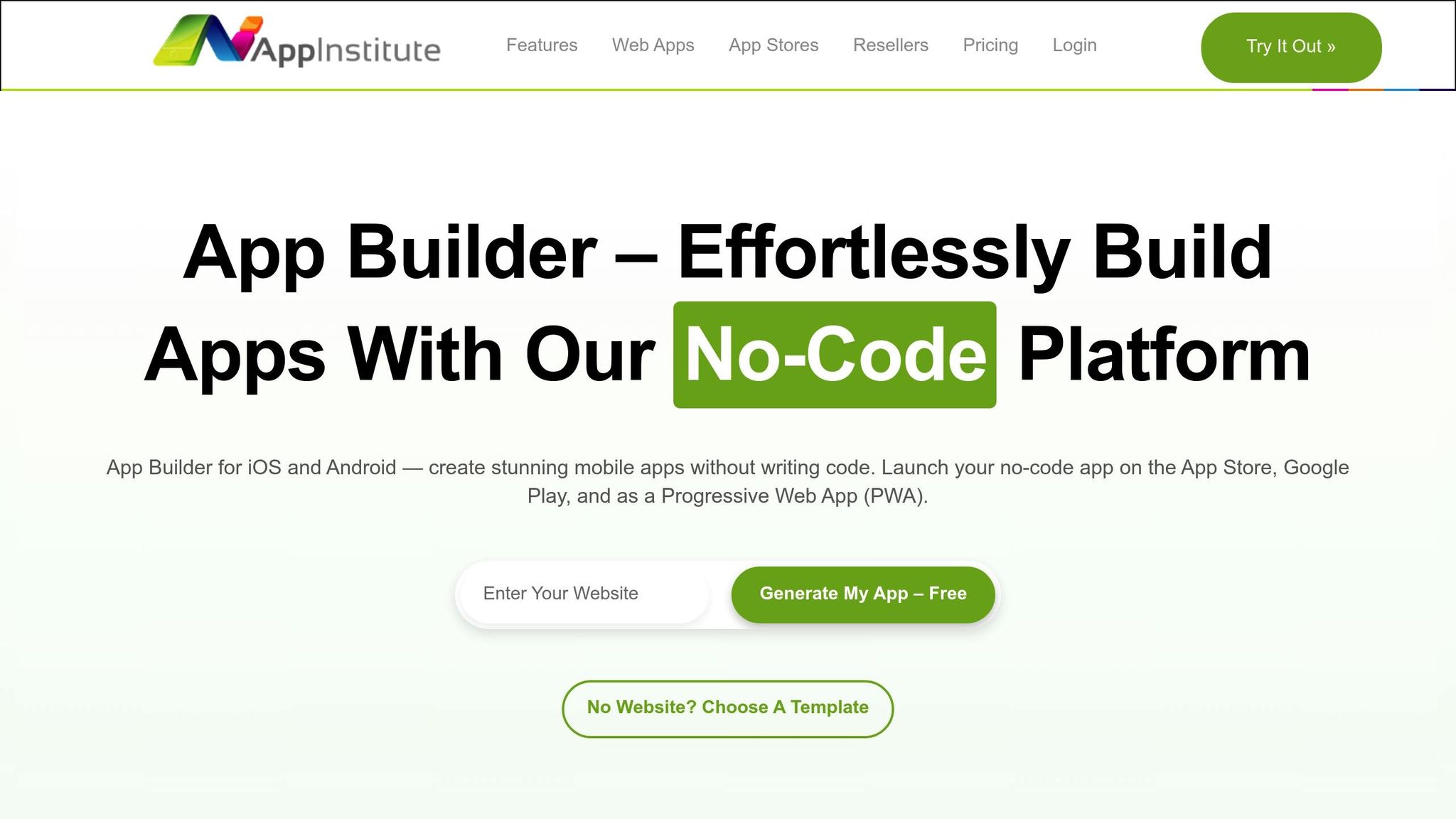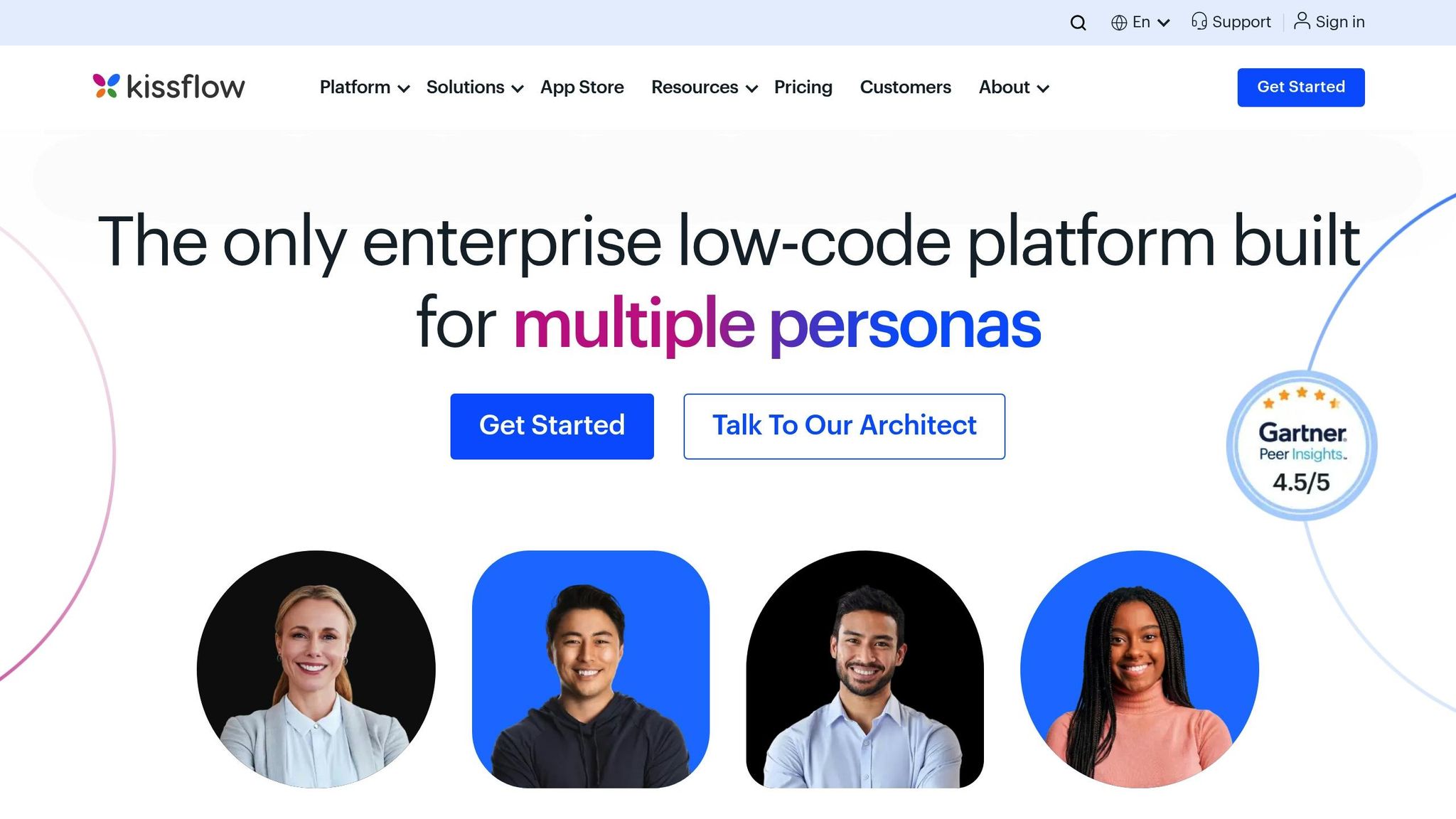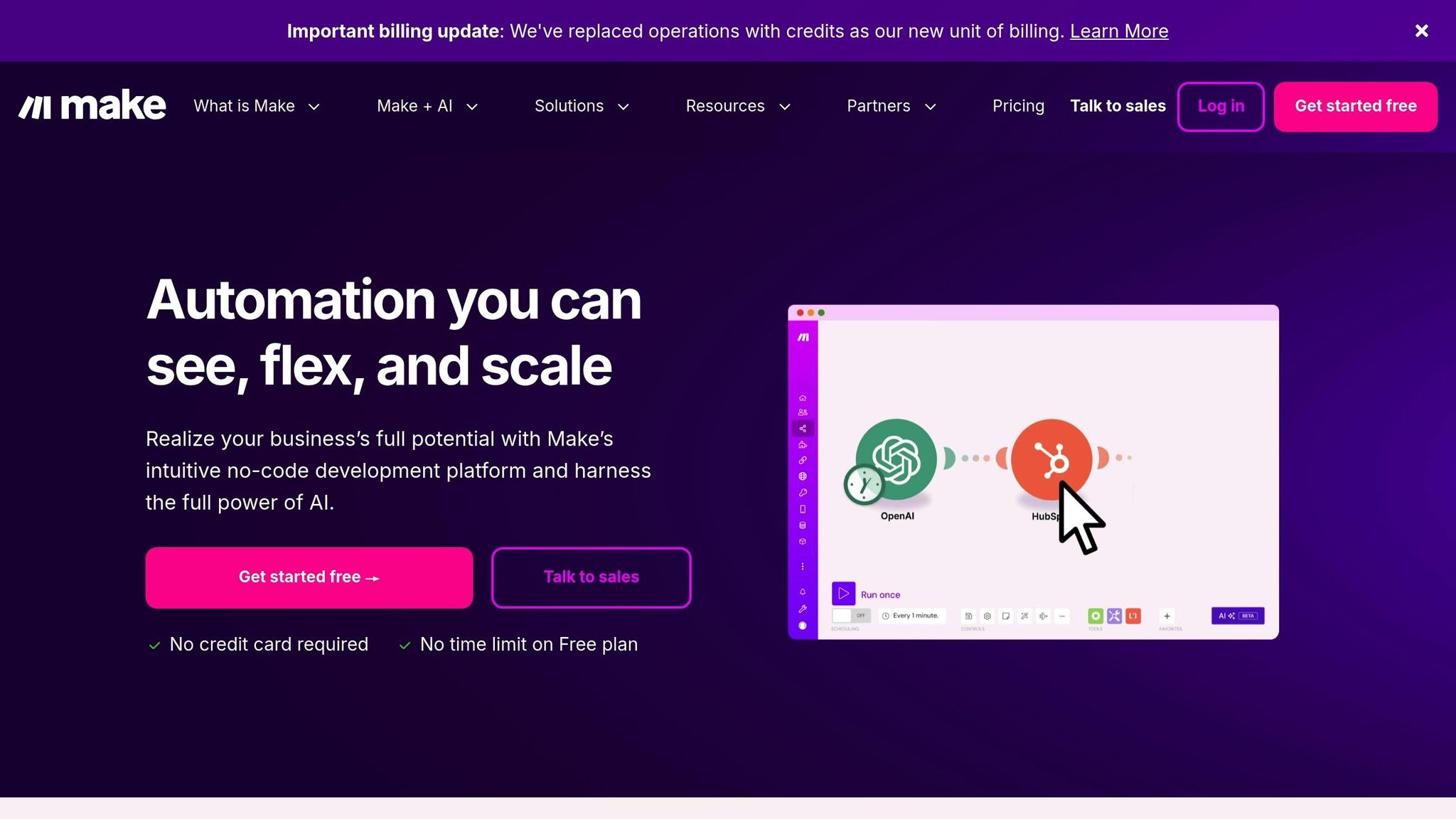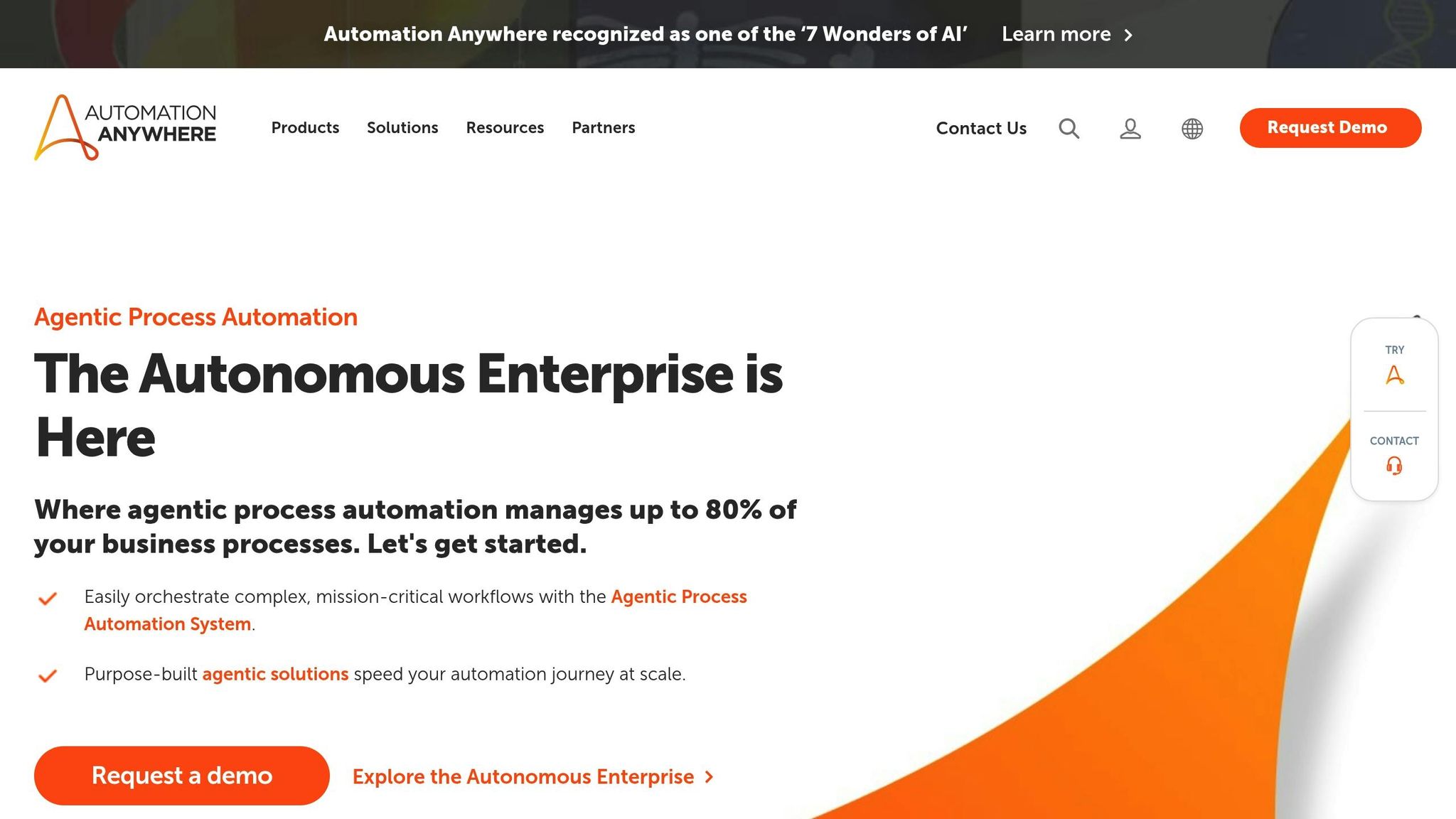Workflow automation platforms simplify repetitive tasks, improve efficiency, and support business growth. These tools help manage increasing workloads without adding extra resources, making them essential for scaling operations. No-code platforms, in particular, empower non-technical users to create workflows quickly through drag-and-drop interfaces. Below are some of the leading platforms for scalable workflow automation:
- AppInstitute: Focused on small businesses, it combines mobile app creation with workflow automation. Features include a drag-and-drop editor, push notifications, and role-based permissions. Pricing starts at $49/month.
- Kissflow: Offers a visual workflow builder for non-technical teams to manage tasks like approvals and onboarding. Custom pricing available.
- Make (formerly Integromat): Excels at connecting over 1,000 apps with a visual, node-based interface for multi-step workflows. Free tier available.
- Automation Anywhere: Designed for enterprise-level automation with AI-driven robotic process automation (RPA) and advanced bot management. Pricing is enterprise-specific.
Quick Comparison
| Platform | No-Code Support | Visual Builder | Key Integrations | Scalability | Starting Price |
|---|---|---|---|---|---|
| AppInstitute | Yes | Drag-and-drop editor | iOS, Android, PWA | Tiered pricing plans | $49/month |
| Kissflow | Yes | Visual workflow builder | Business apps, approvals | Multi-department workflows | Custom pricing |
| Make | Yes | Node-based interface | 1,000+ apps | High-volume operations | Free tier |
| Automation Anywhere | Low-code | AI-powered RPA | Enterprise systems | Enterprise-grade | Enterprise pricing |
Each platform caters to different needs. AppInstitute is ideal for mobile-first businesses, Make specializes in app integration, Kissflow simplifies process design, and Automation Anywhere handles complex automation at scale. Choose the one that aligns with your business size, technical expertise, and workflow complexity.
Best Tools for Workflow Automation for Small Business

What to Look for in Workflow Automation Platforms
When selecting a workflow automation platform, it’s important to weigh several factors that can directly influence how efficiently your business can scale and adapt to change.
No-Code and Low-Code Tools
One of the standout benefits of no-code and low-code platforms is ease of use. These tools empower employees from any department to design workflows without needing programming skills, cutting out delays often tied to IT involvement.
Another advantage is the speed of implementation. In fast-changing business environments, waiting weeks or months for custom development just isn’t practical. No-code platforms allow users to create and deploy workflows in just hours or days, making them ideal for businesses that need to pivot quickly in response to new challenges or opportunities.
Visual workflow builders are another key feature. They simplify complex processes by providing a clear, visual representation of workflows. This makes it easier to understand data flow, spot bottlenecks, and make improvements.
In addition to these benefits, it’s critical to assess how well the platform integrates with your existing tools and whether it can grow alongside your business.
Integration and Scaling Options
API connectivity is essential for seamless communication between the platform and your current software stack. Many leading platforms offer pre-built connectors for popular tools like Salesforce, Office 365, Google Workspace, and Slack. This eliminates manual data entry and ensures that all your systems stay in sync.
As your business expands, scalability becomes a priority. Look for platforms designed to handle increasing data volumes, more users, and complex workflows without losing performance. Cloud-based solutions often excel here, as they can automatically allocate resources based on demand.
Different platforms handle workflow complexity in varying ways. While some are designed for straightforward tasks like approval chains, others can manage intricate workflows with conditional logic, parallel processes, and exception handling. Consider not only your current needs but also how your requirements might evolve in the future.
Data processing capacity is another factor to keep in mind. The platform should be able to handle large file transfers, support multiple data formats, and process thousands of records efficiently, all without compromising on speed or reliability.
Once you’ve addressed integration and scalability, it’s equally important to evaluate the platform’s security and team collaboration features.
Security, Compliance, and Team Features
Strong security measures are non-negotiable, especially if your workflows involve sensitive data. Look for platforms that offer encryption (both in transit and at rest), secure user authentication, and regular security audits. These features are particularly critical for businesses dealing with customer data.
For companies in regulated industries, compliance certifications are a must. Platforms should meet standards like SOC 2 Type II, GDPR for handling European data, HIPAA for healthcare, or PCI DSS for payment processing. These certifications demonstrate the platform’s ability to meet strict regulatory requirements.
User management and permissions are essential for maintaining control over who can access, modify, or execute workflows. Role-based access controls allow you to assign specific permissions to team members, ensuring that only authorized personnel can make changes.
Audit trails and monitoring add another layer of transparency. These features let you track who made changes, when workflows were executed, and what data was processed. This visibility is invaluable for troubleshooting, optimizing performance, and demonstrating compliance during audits.
Finally, team collaboration features can significantly enhance workflow development and maintenance. Look for platforms that offer tools like version control, commenting systems, and collaborative editing. These features make it easier for teams to work together on automation projects, especially as more employees get involved in streamlining processes across the organization.
AppInstitute

AppInstitute is a no-code platform designed to help small businesses create professional mobile apps while automating essential business processes. By combining app development with automation, it supports broader workflow strategies, making it easier for businesses to streamline operations.
Main Features
AppInstitute offers tools that enable businesses to build and manage apps effortlessly:
- Drag-and-Drop Editor: At the heart of AppInstitute is an easy-to-use editor that allows users to design custom workflows without any coding knowledge.
- Industry-Specific Templates: These templates simplify app creation, speeding up deployment for various business types.
- Push Notifications: Businesses can automate alerts triggered by user actions or specific times, keeping users informed in real time.
- User Management: The platform includes role-based permissions, ensuring employees, managers, and customers have appropriate access levels.
- App Store Submission Service: AppInstitute handles the technical details of publishing apps to major app stores, including unlimited resubmissions, making the process hassle-free.
Scaling Options and Use Cases
AppInstitute is designed to grow alongside your business:
- The platform adapts to accommodate increasing user demands, ensuring reliable performance as your customer base and data volume expand.
- Agencies and consultants can leverage the reseller program to offer AppInstitute solutions to their clients.
- For businesses needing more advanced features, the "Hire A Pro" service connects them with professional developers for custom solutions.
Small businesses frequently use AppInstitute to automate tasks like customer ordering and loyalty program management. For instance, restaurants can create apps that process orders automatically and send confirmation notifications. The App Stores Premium plan also supports tablet optimization, enhancing the user experience on larger screens.
Pricing Plans
AppInstitute offers flexible pricing, making it accessible to startups and growing businesses. Each plan is billed monthly in U.S. dollars and supports one app per subscription, allowing businesses to scale their app development as needed.
| Plan Name | Price (Monthly) | Description/Tagline | Features | Limitations/Restrictions |
|---|---|---|---|---|
| Instant | $49/mo | Instant access to your app via QR Code & Web Link | Progressive Web App, Connect Your Domain, Push Notifications, User Management | Single app per subscription |
| App Stores | $99/mo | Go live on Apple & Google Play Store | All Instant features + Apple App Store App, Google Play Store, Submission Service, Unlimited resubmissions | Single app per subscription |
| App Stores Premium | $149/mo | Premium app with tablet support | All App Stores features + iPad Support, Android Tablet Support, Dedicated Account Manager, Free Hire A Pro Service | Single app per subscription |
The App Stores Premium plan stands out by including a dedicated account manager who provides personalized support, helping businesses fine-tune their apps and improve workflows efficiently.
Other Workflow Automation Platforms
In addition to AppInstitute, there are several other platforms designed to help businesses streamline their workflows. These solutions focus on simplifying processes, integrating multiple tools, and scaling to meet growing demands.
Kissflow

Kissflow bridges the gap between business teams and IT by offering a visual workflow builder that doesn’t require coding expertise. This makes it easy for non-technical users to design and automate processes. The platform includes templates for tasks like employee onboarding, expense approvals, and procurement, which can be tailored to specific needs.
One of its standout features is the ability for business teams to take an active role in creating and refining workflows. This helps cut down on delays that often occur when projects rely solely on IT departments. Managers can keep a close eye on progress through real-time dashboards, which highlight bottlenecks, completion rates, and team performance. Whether you need a straightforward linear workflow or a more complex process with multiple approval paths and conditions, Kissflow has you covered.
While Kissflow simplifies process design, Make takes a different approach, focusing on connecting applications seamlessly.
Make (formerly Integromat)

Make is all about linking applications and building automation workflows through its visual, node-based interface. This approach makes even complex integrations feel more manageable and user-friendly.
The platform is particularly effective at handling multi-step workflows, ensuring smooth data transfers between systems. For instance, you could set up a scenario where data is pulled from a CRM, formatted according to specific rules, stored in Google Drive, and then shared via notifications across multiple channels – all in one automated process.
Make also shines when it comes to troubleshooting. It offers detailed execution logs and debugging tools, making it easier to identify and fix errors. For advanced users, there’s the option to use custom functions and filters to fine-tune data manipulation as it moves between apps.
While Make focuses on connecting apps, Automation Anywhere takes automation to the next level with AI-driven solutions.
Automation Anywhere

Automation Anywhere specializes in enterprise-level robotic process automation (RPA) with the added power of AI. It’s designed to handle repetitive tasks that require interacting with existing software, even older systems that don’t have modern APIs.
The platform’s AI capabilities are particularly useful for working with unstructured data, such as emails, invoices, and other documents. Its IQ Bot learns from human corrections, gradually improving its accuracy when dealing with similar tasks or data patterns in the future.
For IT teams, Automation Anywhere provides a centralized control interface to manage automation processes across a large number of digital workers. These bots can be deployed in two ways: attended bots, which assist employees in real time, and unattended bots, which operate independently on a schedule. Both options are ideal for managing high-volume, repetitive tasks efficiently.
Each of these platforms offers unique strengths, catering to different aspects of workflow automation – from visual design and app connectivity to advanced AI-powered processes.
sbb-itb-539ae66
Platform Comparison
Selecting the right workflow automation platform requires a clear understanding of how each solution aligns with your specific goals. The platforms highlighted here bring different strengths to the table, from mobile app development to enterprise-grade automation. This comparison focuses on how these platforms handle scalability, integration, and usability, allowing you to weigh their core features side by side.
Feature Comparison Table
| Platform | No-Code Support | Visual Builder | Key Integrations | Scalability | Starting Price |
|---|---|---|---|---|---|
| AppInstitute | Yes | Drag-and-drop editor | iOS, Android, PWA, App Stores | Enterprise plans with dedicated support | $49/month |
| Kissflow | Yes | Visual workflow builder | Business apps, approval systems | Multi-department workflows | Custom pricing |
| Make (formerly Integromat) | Yes | Node-based interface | 1,000+ apps | Complex multi-step scenarios | Free tier available |
| Automation Anywhere | Low-code | AI-powered RPA | Enterprise systems, legacy software | Enterprise-grade with bot management | Enterprise pricing |
This table provides a snapshot of how each platform handles key aspects like no-code support, integrations, and scalability.
Platform Highlights
- AppInstitute: Tailored for mobile app creation, AppInstitute simplifies app deployment with a drag-and-drop editor. Its pricing ranges from $49 to $149 per month, offering features like tablet support and dedicated account management at higher tiers. This makes it a solid choice for businesses focusing on mobile-first strategies.
- Make (formerly Integromat): Known for its powerful connectivity, Make allows businesses to link over 1,000 apps with a visual, node-based interface. It’s ideal for handling multi-step workflows where data needs to move seamlessly across various systems, all without requiring coding expertise.
- Kissflow: Designed for business users, Kissflow enables non-technical teams to create workflows independently. This reduces delays by bypassing the need for IT intervention, making it a practical option for organizations aiming to streamline approval systems or business processes quickly.
- Automation Anywhere: Positioned at the enterprise level, Automation Anywhere specializes in robotic process automation (RPA) powered by AI. It excels in automating interactions with legacy systems, though it may require more technical know-how. Its centralized bot management ensures scalability for large-scale operations.
Scalability Considerations
Scalability differs across platforms, depending on their focus and infrastructure.
- AppInstitute offers predictable tiered pricing, making it easier for businesses to scale while adding professional services and advanced features.
- Make supports high-volume operations with robust processing capabilities, making it a go-to for handling thousands of transactions monthly.
- Automation Anywhere provides enterprise-grade scalability through centralized management of digital workers, catering to growing process complexities.
When deciding on a platform, think about your team’s technical expertise, budget, and the complexity of your workflows. For mobile app development, AppInstitute offers a straightforward path. If your focus is on connecting multiple tools seamlessly, Make is a strong contender. For enterprise-level needs, Automation Anywhere delivers advanced automation powered by AI.
As automation continues to evolve, platforms with AI-driven features are well-positioned to meet the demands of increasingly complex workflows.
How to Scale Workflow Automation
Scaling workflow automation requires careful planning and smart decisions from the start. Systems that work well for a small team might struggle to handle increased complexity, transaction volumes, or stricter compliance requirements as your business expands. Choosing the right tools early on can save you from expensive and time-consuming transitions later.
Picking the Right Platform
When selecting a platform, think long-term. Strong integrations should be at the top of your checklist. A platform that only connects with a few apps may suffice at the beginning, but as your tech stack grows, it could become a bottleneck. Look for platforms with robust APIs and plenty of pre-built connectors that integrate seamlessly with your existing tools.
Test the platform under conditions that reflect your actual use case. Instead of relying on demo scenarios, use real data volumes to ensure the system can handle your specific needs.
Compliance is another critical factor. Make sure the platform meets U.S. standards like SOC 2 Type II or HIPAA to avoid regulatory headaches or costly migrations down the line.
Think about your team’s technical expertise. No-code platforms, like AppInstitute, can simplify workflow creation and updates. With its drag-and-drop interface, even non-technical team members can adapt workflows as needs evolve, reducing reliance on IT and speeding up implementation.
Finally, consider pricing. Transparent, tiered pricing models make it easier to predict costs as your business grows. Don’t forget to account for additional expenses like training, implementation, and consulting fees when comparing options.
Tracking and Improving Performance
After choosing a platform, ongoing monitoring and optimization are essential to maintain scalability. Real-time dashboards can help you track processing times, error rates, and system availability. Set up alerts to catch performance issues before they impact users. Even small delays, like a 2% increase in processing time, can add up when you’re handling thousands of transactions daily.
Use logging to capture detailed information about failures, including user actions, system states, and external factors like API rate limits. Address issues based on their severity and impact on your business.
Regular feedback loops are key. Combine user input with performance audits to identify bottlenecks. Monthly workflow reviews can help you evaluate processing times, resource usage, and patterns in user feedback.
Capacity planning is crucial during periods of growth. Keep an eye on usage trends and project future needs. For instance, if your platform currently processes 10,000 transactions a month and your business grows by 20% each quarter, plan for infrastructure that can handle 25,000+ transactions.
Build optimization cycles into your strategy. Schedule quarterly reviews to refine workflows, update integrations, and remove unnecessary steps. What works for a small team may become cumbersome as your organization grows.
Always test changes in a staging environment that mirrors your production setup. This is especially important when integrating new tools or updating processes. Testing ensures that even minor tweaks don’t disrupt the entire system, helping you maintain the scalability you’ve worked so hard to achieve.
Conclusion
Picking the right workflow automation platform can make or break your business growth. The key? Finding a platform that aligns perfectly with your needs and goals.
One standout approach is empowering non-technical teams. No-code platforms like AppInstitute allow entire teams to create workflows quickly, making it easier to adapt to market shifts. This kind of accessibility becomes even more critical as your company grows and departments require more independence.
It’s also important to focus on integration capabilities, compliance requirements, and straightforward pricing. These elements ensure your automation scales effectively without hitting costly roadblocks. A platform that handles 1,000 transactions today but falters at 10,000 won’t just drain your budget – it’ll slow your momentum when you can least afford it.
Automation isn’t a "set it and forget it" process. Success comes from pairing the right platform with regular performance checks to ensure your workflows evolve alongside your business needs. The platform you choose should make that evolution smooth, not a headache.
For U.S. businesses navigating strict regulations and fierce competition, scalable workflow automation is non-negotiable. Platforms offering strong security, reliable APIs, and clear upgrade paths can help you grow without unnecessary risk. The investment you make now in automation will shape your operational efficiency for years to come, so choose carefully, test thoroughly, and plan for growth from the start.
These considerations tie back to earlier points on integration, scaling, and team collaboration, emphasizing their importance in building a successful automation strategy.
FAQs
What should growing businesses look for in a workflow automation platform?
When choosing a workflow automation platform for a growing business, it’s important to consider a few key factors. Start with scalability – you’ll need a platform that can handle increased demands as your business expands. Look for one that’s easy to use, so your team can adopt it without a steep learning curve, and ensure it offers strong integration capabilities to connect smoothly with the tools you already rely on.
You’ll also want to keep security in mind to safeguard sensitive information. Evaluate the platform’s cost-efficiency to make sure it fits your budget without compromising on features. Lastly, check for customization options that allow you to adapt the platform to match your specific workflows. Picking a solution that evolves alongside your business is a smart move for long-term growth.
How can no-code and low-code platforms help non-technical users streamline workflows?
No-code and low-code platforms give non-technical users the ability to create, test, and manage workflows through user-friendly tools like drag-and-drop editors. These platforms break down complicated processes into manageable steps, making it easier to implement solutions quickly and adapt them as needed.
By eliminating the need for programming knowledge, these tools let users concentrate on boosting efficiency and tackling challenges with a creative mindset. This approach to app development not only saves time but also encourages teams to explore new ideas and come up with inventive solutions.
Why is integration essential for scaling workflow automation platforms, and how does it benefit business growth?
Integration plays a key role in scaling workflow automation platforms by enabling smooth communication between various systems. It connects tools and platforms, reducing the need for manual tasks, cutting down on errors, and boosting overall efficiency.
With improved efficiency, businesses can shift their focus from repetitive tasks to strategic goals, driving growth. Integration also ensures data accuracy and accessibility, giving businesses the insights they need to make smart decisions and stay competitive in a constantly evolving market.
Related Blog Posts
- How to Build an App Without Coding Skills
- 5 Tips for Scaling No-Code Apps
- Top 7 No-Code Trends for Cross-Platform Apps 2025
- Best Practices for No-Code Workflow Design
Last Updated on September 3, 2025 by Ian Naylor

0 thoughts on “Top Platforms for Scalable Workflow Automation”